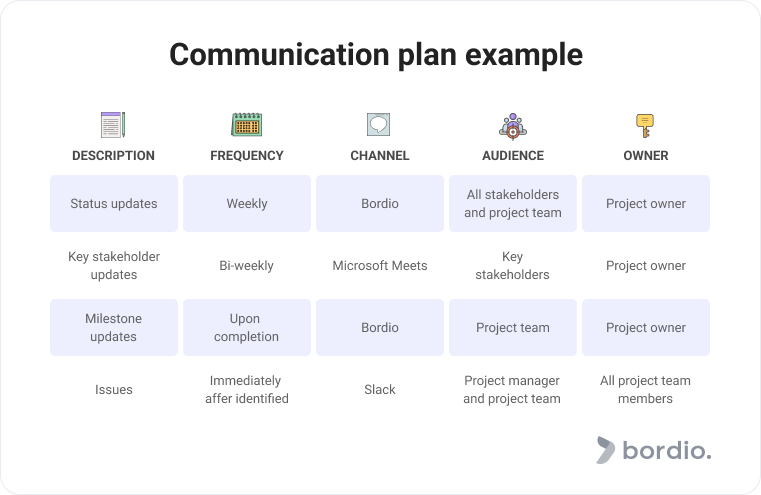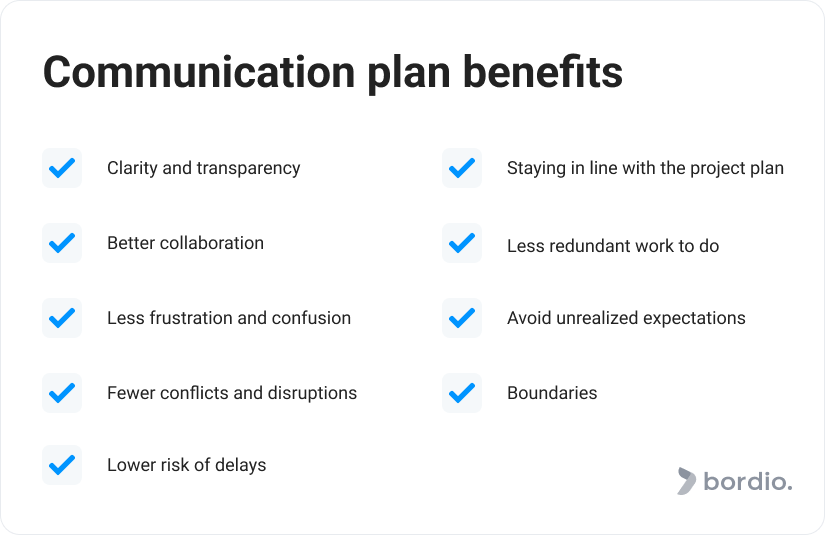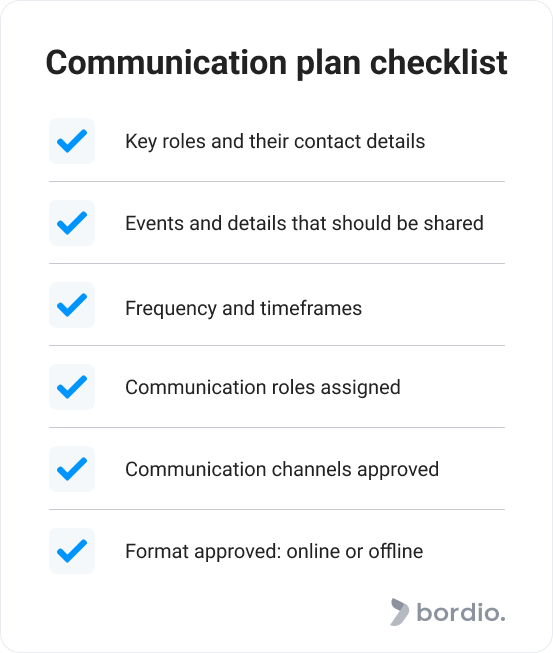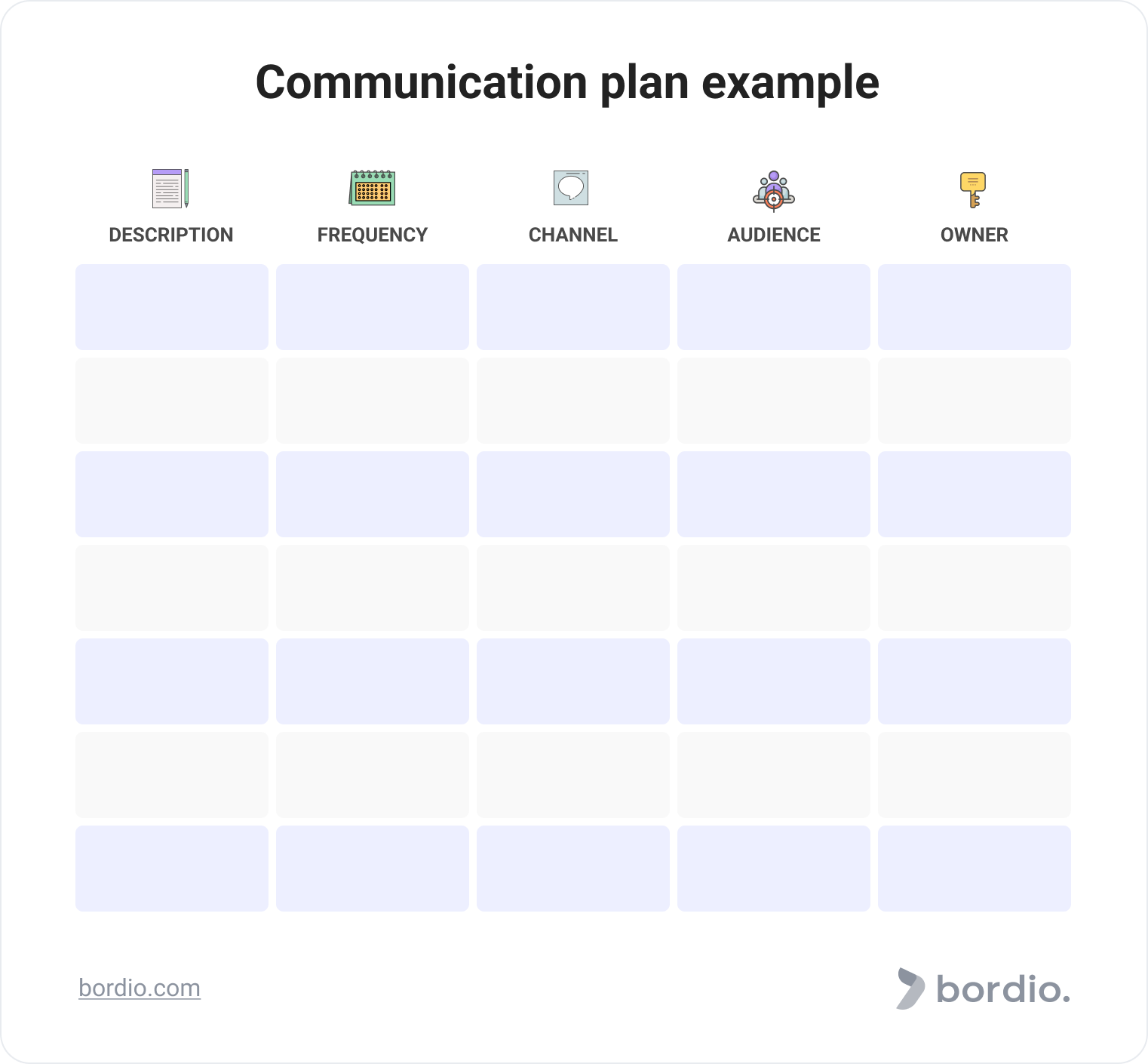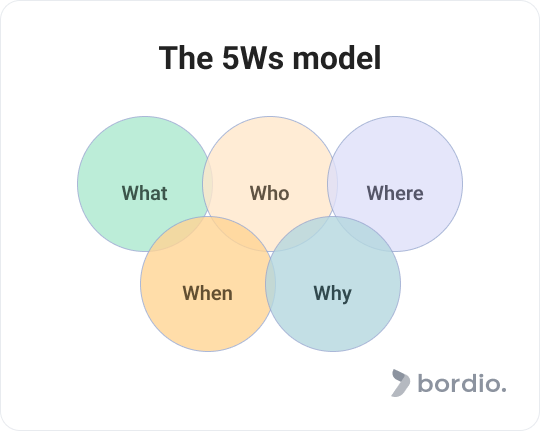Every project manager knows that communication is the key to success.
The way you communicate, how often you do it, and who you are communicating with can easily make or break the project. And when many different people get involved in a process, building healthy communication becomes a challenge.
Having a communication plan in your work management systems helps the project management team navigate this process to the advantage of the project.
And if you haven’t yet heard about communication plans for projects and don’t know what it means, we have you covered! Today’s article will share what a good communication plan consists of, how it can be created and followed, and more.
And if you’d like to learn more about project management in general, check the why project management is important article by the Bordio team.
What does a communication plan mean?
In simple words, a project communication plan is a guideline on how, when, and to whom specifically to share ongoing project updates, report issues, raise concerns and share any other information that might be of interest to stakeholders.
The communication plan creates a structure and serves as a reference point for anyone involved in the project, making sure all team members receive 100% of the information they are supposed to.
The key benefits of having a communication plan
A project management communication plan is often ignored or forgotten about because there are so many other things to do, such as planning your schedule when preparing for a project to start.
We want to change that dynamic by talking more about the communication plan as such, and its benefits for project managers, team members, and key stakeholders.
So, here are the main advantages that a project communication plan can provide:
-
Clarity and transparency. People often make fun of those who are very organized and have every aspect of their lives structured. But don’t you want this in your professional life? Especially in project management, where stakes are so high? A good project communication plan made in good personal project management software will help facilitate the project progress and reduce the stress levels associated with the lack of order, making everyone’s day a little bit easier. For example you might use Bordio’s best online project management tools and online time planners.
-
Better collaboration. If there is an easily accessible document with everyone’s responsibilities and contact information, the project team members are more likely to have a pick into it, find someone they can discuss work with, and engage in a conversation.
-
No confusion and frustration. Projects get messy very quickly. Even a small project team can drown in the hectic environment, especially if they’re not using powerful online to-do lists, like best task organizer by Bordio, and make mistakes that don’t help the process. If everyone knows which team members to reach out to in what scenarios, it leads to a more friendly atmosphere, more effective communication, and faster issue resolution.
-
Fewer conflicts and disruptions. If something doesn’t go according to plan, the sooner you approach a responsible person and deal with the situation, the less likely it is to escalate. Remember those emails with 30 recipients who get notified about something and nobody takes action (because hey, somebody else will deal with it for sure!) causing a disaster in the end? Yep, that’s exactly what we are trying to avoid with a communication plan.
-
Lower risk of delays. Similar to the previous comment, if a feature in a new software product doesn’t work and team members don’t know who to notify about it, the issue doesn’t get fixed. And that, in turn, means that the next steps are delayed, creating a risk for the overall project delivery.
-
Staying in line with the project plan. The communication plan contributed to the project staying within the scope, budget, and timeframe. As one more layer of structure, the plan makes the working process easier and more coherent.
-
Less redundant work done. A less obvious benefit of the plan is not doing the extra work that takes time but doesn’t provide value. If we make a list of employees and highlight who needs to be reported about what, then we can easily spot and eliminate duplicate reporting, as well as incorrect execution of the reporting because we identify criteria with which information needs to be provided. In large companies or big teams, there is a common issue where employees are forced to provide similar data to multiple people in different formats. Needless to say, that’s not efficient. And the communication plan catches that before it becomes a burden and causes burnout. Also to avoid this you can store everything in a common form for the team – virtual planning.
-
Avoid cognitive bias like unrealized expectations. Let’s say someone assumed they would be notified about an event, but they weren’t. How would they feel? Probably not that great. A successful communication plan will eliminate the risk of unrealized expectations that can often lead to conflicts. And a free online calendar planner used in project management guarantees that if someone has a task or an event, they won’t ever miss a notification about it. We can recommend weekly schedule planners.
-
Boundaries. Having boundaries is important in life in general, and professional life is no different. Apart from everything else, the plan will include things like communication preferences (whether someone wants to receive calls or emails only) and communication styles (some employees might not tolerate cursing or, the opposite, too formal communication). That will define what’s acceptable and what’s not, helping everyone feel confident and comfortable.
Ultimately, the main benefit is that the plan gets everyone on the same page and keeps them there.
What is included in a project communication plan?
Now that we’ve identified why the communication plan is important, let’s cover what should be included in one.
Please note that the best plan is the one that’s tailored to your unique needs. So, if you find a project communication plan template that almost fits you, don’t hesitate to adjust it to your situation.
The basic points that the plan should include:
#1 Key roles in the project and contact details
If you work on a complex project that engages a large number of people with multiple managers and subordinates, it might be sufficient to only limit the contact information of the line managers and their superiors, and also contacts of some other important people who are involved and useful in the project, such as the best saas marketing companies. With smaller teams and in situations when there is no clearly defined authority system, like Scrum, Agile, or Kanban, it makes sense to list every single team member and stakeholder.
Pro tip: Refer to your time organizer software for insight and details of key stakeholders in the project. Check past projects for additional information.
#2 Project-related events and details that need to be communicated
Think about the topics and occurrences that require communication.
There is no single guideline to what has to be included here but it would be worth adding things like achieved milestones, changes in the roadmap, new risks, change requests, leading strategic discussions, external disruptions, sick leaves.
When working on this part of the communication plan, engage your colleagues to get a second opinion and make sure you won’t miss significant events from your plan.
Pro tip: Project managers should learn to balance between not communicating enough and communicating too often. Unless you want to be ignored and treated as white noise, it’s important to stick to what’s really important and impactful.
#3 Communication frequency and timeframes
Once we’ve identified the list of key contacts and events that have to be shared, we need to identify how often we share:
- Periodic updates, like general project news or progress with deliverables.
- How soon after the one-time event other stakeholders should be notified. For example, if there is a critical error in the software, does the project manager have to be contacted within 1 hour, 1 day, or 15 minutes?
It’s best to outline the timeframes for each occasion and put it in a single communication schedule. Otherwise team members will do it based on their own judgment which might differ from what key stakeholders have in mind.
#4 Assigning the communication roles
We already what should be communicated and how often, and who is engaged in the project.
In this part of the communication plan, we need to identify who should be contacted by who in what situation. For example, if we are building a house and the supplier delivered poor-quality concrete, a supplier manager will need to notify the construction site supervisor.
If we don’t define the messenger and the recipient of the message, we open ourselves up to all kinds of issues, like no one doing anything at all, or someone telling the news to the wrong person who is not in the position to take necessary action.
Some news and events require formal approval, so for those types of occasions, having a responsible person assigned is a must.
#5 Channels of communication approved
The key at this point is to identify how do we communicate with one another. What channels are we using? Some startups that practice Lean would stick to messengers and zoom calls, whereas the public sector working under the PRINCE2 framework has security requirements, including steps like HLR lookup, which necessitate using proven communication methods, such as emails and Microsoft Teams, to ensure secure and reliable information exchange.
Apart from policies and regulations, another factor to be considered is the personal preference of the employees. If everyone’s fine with using Skype for calls and chats, it would be counterproductive to impose something else.
A great project manager will take the time to work out a system that will satisfy the majority. As silly as it sounds, many people across all levels will jeopardize the process over such little things as the communication methods they personally don’t enjoy.
#6 When does communication have to be in person and online
This last part of the communication plan template might not be as relevant in the post-pandemic world. However, it makes sense to separate the communication topics into online and in-person meetings.
As we’ve seen with recent mass firing zoom calls, people don’t react as well to some news if they are presented in the wrong format. Now, we are hoping you won’t be firing anyone during the project, but you get the gist. There are likely to be some sensitive topics that would require empathy and personal engagement. Also, everyone should individually schedule in their free digital daily planner these meetings so as not to miss anything.
What should not be a part of the communication plan?
The project communication goals are all about contact within the team and with stakeholders. Things like PR-related announcements should be excluded.
Examples of what does not apply to the communication plan:
- Social media coverage.
- Emails and sales calls to clients.
- Scripts to primary client contact.
- Target audience information.
- Positioning to those target audiences.
How to create a smart communication plan
Here are a few tips to help you make your own communication plan and use it as a project management tool for future successful projects.
- Define every communication method and channel you’d like to use (in-person or online, video chat in Zoom, slack chat; synchronous or asynchronous communication).
- Define what needs to be communicated. Create an approximate list and keep it together with other written documentation. Some things you won’t be able to predict but the majority of the events and topics would not be a problem to remember for any project manager.
- Assign owners to different communication events (Who talks about milestones? Who shares project status updates?) and viewers who will need to approve the update (if applicable).
- List the frequency of communication on different elements of the project (e.g. weekly updates on the overall progress to key shareholders).
- Create a separate schedule for all pre-planned communications (like weekly check-ins with the team on the budget side of the project) or include them in the main project schedule.
For your convenience, you can use the communication plan template that we’ve created at Bordio. You can download it as a PDF here:
Don’t forget to consider shareholders in the plan creation. Ask for their opinion and input to avoid difficulties down the line. Also, plan additional time in your weekly planner to meet with them and explain why the project communications plan is there and how it benefits them personally.
If this is the first time a project manager uses a communications plan in their project, they will need to be extra diligent with persuading and documenting every step of the way.
It would also make sense to add project communication plan examples to the company’s inner system for future reference.
Standardizing the process will take some time, so beware of the rough patches. Also, don’t forget to update the plan every once in a while as the project continues to reflect the latest state of affairs.
Communication plan checklist
Although we can’t recommend using any specific project communication plan template, here is a brief checklist to give you a head start in your communication planning process:
- Description
- Frequency
- Method
- Audience
- Owner
The 5Ws model
An alternative take on structuring your project communication plan is via the 5Ws model that helps you with the 5 questions:
- What needs to be communicated? (e.g., a bug in the latest product increment)
- Who should be notified about it? (the developer who wrote the code)
- Where should communication take place? (via email to be logged properly)
- When should the contact take place? (as soon as possible)
- Why is this timeframe for communication chosen? (the issue has to be fixed before the sprint ends)
Final thoughts on project communication plan
Project management recognizes and emphasizes the importance of proper planning and its role in project success. All top project management books praise planning as the key contributor to achieving project goals.
However, not so much hype is happening around the project management communication plan, although it’s just as important in our humble opinion.
A communication plan creates a workflow that all team members and project stakeholders can refer to throughout the entire project execution process. It streamlines the process and facilitates effective communication that lowers project risks and makes the process smoother.
Time management is important when working on projects, and a communication plan will contribute to smarter use of everyone’s time, and will ultimately help cross out more tasks from everyone’s online daily planner and achieve better results.


